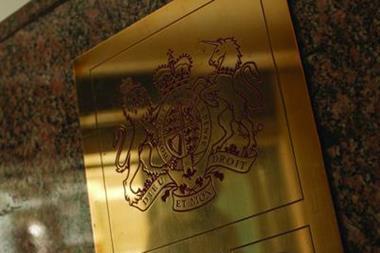‘Pre-wash, wash and spin-dry’ are the cycles that apply to a washing machine and to money laundering. It may appear odd to compare the two but they reflect a reality based in law and in history, explains Charlotte Gaudin
When the American government brought in prohibition in the 1920s, it did not think for a moment that it was going to enable Al Capone to make a fortune. Capone decided to apply the rules of capitalism to major crime by setting up his stall with an offering based on the trinity of 'alcohol, girls and games’. Huge sums of cash began to flow into his coffers, all of which had to be laundered.
Investing in laundries became necessary. With the services being paid for in cash, how could one know that the money declared came from criminal activities rather than from doing the washing? The money was thus pre-washed by means of a false turnover declaration, washed by paying taxes on it to the tax authorities, and then spun dry by the resulting net proceeds.
The aim of laundering lies not so much in increasing the funds taken in, but rather to allow those involved to profit fully from them. A million dollars worth of laundered money in an account is worth more than five million stashed in a suitcase. Unsurprisingly, the cycle of transforming dirty money into clean money constitutes one of the criminal fraternity’s most critical processes, because of the enormous amount of value added.
Unfortunately, organised crime has not declined since the 1920s – far from it! On the contrary, it has increased and gone international. With their income still being amassed in liquid cash, criminals have not only learnt how to adapt themselves to globalisation, but have turned themselves into experts, capable of using the most sophisticated techniques for laundering dirty money.
The fightback began in the course of the 1980s, encouraged by two factors. First, the UN became aware that the international mechanisms and systems in place in the fight against drug trafficking were not effective enough in view of the changing nature of this illegal commerce. As it was an activity that ignored frontiers, only suitable action by the international community as a whole would make it possible to fight it. The Vienna Convention on illegal drug trafficking was adopted in 1988, forcing the signatories to make the laundering of drug-trafficking proceeds a criminal offence.
Soon afterwards, the G7 countries realised that a volume of funds in international commerce was not accounted for. And what a volume! The gross criminal product is today estimated to be between $1,000bn and $1,500bn per annum, in other words an amount greater than the GNP of Spain. It was essential, therefore, to find some suitable response to this unaccounted for, and particularly, untaxed, flow of funds. The Financial Action Task Force (FATF) was created, and with it has come an abundance of international legislation covering all aspects of the fight against money laundering. Its mission is to define and promote the appropriate measures to thwart the use of the financial system by criminals.
At the same time, the EU has provided itself with means to get its member states to integrate all the measures likely to fight dirty money effectively, into their national laws. The EC thus turns every development of the standards laid down by the FATF to good account. However, member states who might be tempted to adopt protectionist legislation so as not to see their economies overrun by dirty money, could negate all the Commission’s efforts to harmonise national legislation and construct a single market. To help counter this risk, the Commission is involving players in the private sector in defending the integrated financial market and consequently the single market in its much broader sense.
At first the EC limited how far its legislation reached by only requiring credit and financial institutions to be vigilant. These are obliged to check the identity of any of their customers undertaking financial transactions involving more than €15,000 that could conceivably have originated from drug trafficking. This check goes along with a requirement to keep all documentation and an obligation to cooperate fully and entirely with the appropriate authorities, whether this be as a first step (declaring a suspicion to the Financial Intelligence Unit – FIU), or after the event (cooperating with the police or legal authorities, in the case of investigations and proceedings).
Focused initially on the participation of financial organisations in the fight against the laundering of capital originating from the drug trafficking, the battlefield is progressively extending to the proceeds of all crimes, while at the same time, the sectors concerned are expanding to include non-financial professions that are also exposed to the risk of money laundering.
“The real challenge lies in implementing all the control mechanisms and dealing with the risks identified.
Terrorism triggered the international conscience
In 2001, the 11 September attacks made national and international authorities push through anti money laundering laws much more rapidly. The US voted in the Patriot Act, the FATF revised its 40 recommendations by adding eight new special recommendations concerning the financing of terrorism, while the EU finalised its own legislation. The evil goes much deeper now; it is no longer just a question of just laundering the proceeds of daily criminal activities, but also of supplying international terrorist networks.
The years 2004 and 2005 cast a tragic shadow over Europe when three attacks were carried out on European soil, in Madrid and London. Since terrorism is not confined to the US mainland and terrorist networks are spread across the whole of Europe, the EU had to provide itself with the necessary measures to fight against a new type of plague.
Now credit and financial institutions, legal professions, insurance companies, mutual societies, casinos, statutory auditors, estate agents and so forth, have an obligation to be vigilant. Such organisations must know the identity of the actual beneficiary, as well as that of all those either closely or remotely concerned with the operation, and satisfy themselves that the operation makes economic sense. All suspicions must be voiced for any and all operations that could conceivably be linked with drug trafficking, organised crime, serious fraud, corruption or terrorism. And, in an attempt to ensure that the professionals comply with this obligation, new legislation obliges member states to make provision for sanctions, as much administrative as penal, if these obligations are not complied with.
The French approach
Even though it signed the UN Convention on illegal drug trafficking in 1990, France did not bring in a money laundering offence until 1996. This new type of offence cracked down on two different types of behaviour: money laundering for one’s own account and doing it on behalf of someone else. In the latter case, one can be found guilty of money laundering if one 'helps or assists in any way with a deposit, or with hiding or converting proceeds that originate, either directly or indirectly, from a crime or a misdemeanour’.
A credit institution (or any other affected organisation) could thus find itself being accused of money laundering on someone else’s behalf if it does not implement control measures to detect and reject these types of operations.
All French banks are subject to supervision by the banking commission, the controlling authority responsible for ensuring that all the institutions that come under its jurisdiction hold a minimum of their own funds, comply with the rules on prudent supervision or financial communications and more generally with all the provisions applicable to credit institutions, including the obligation for national vigilance.
In order to comply with the various statutory obligations, banks have an internal control mechanism, which has, as one of its functions, to check that the institution does not carry out operations that might constitute money laundering. However, recent events affecting the French banking system and showing up the deficiencies of the various control mechanisms, makes one fear the worst.
“A credit institution could find itself accused of money laundering on someone else's behalf.
In spite of the measures made available by the founding treaties of the EU, provisions are rarely put in place when due by the member states. As yet, there have been no French measures taken to transpose the 2005 directive. In fact, no national implementation measures have been adopted in the UK or the rest of Europe either.
Even though the onus of penal responsibility may concern the banker as much as the bank, it does not stop the legal maxim nemo auditur propriam turpitudinem allegans (no-one is heard when alleging their own wrongdoing) from being applied in cases where France has not yet transposed the third directive. So the country cannot blame its administrators for not applying the above-mentioned directive when it, itself, has not complied with its intrinsic provisions. It has not transposed it and so it has not rendered it applicable. The national authorities cannot therefore commence disciplinary proceedings against any organisations under their sway for non-compliance with the provisions contained in the directive.
With the banking sector not being the only one affected by this obligation for vigilance, it would appear to be imperative that all of the professions involved in anti money laundering regulations take cognisance of the magnitude of the obligations to which they are subject, so as to bring into effect internal vigilance procedures and to do this in order to respond to the risks resulting from the European legislative provisions not being applied (for example, a risk of non-compliance). And so, casinos, which are controlled by Treasury accountants, insurance or mutual companies, whose supervisory body in France is ACAM, and all the other professionals affected by the European anti-money laundering legislation should, sooner or later comply with the various vigilance measures.
It is essential that the operatives charged with the fight against money laundering in the sectors under discussion should be properly trained, should understand suspect operations and should be effective and not just compliant. The risks inherent is ignoring what could give rise to an obligation for vigilance, are very real. At the administrative level alone, the supervisory authorities have the right to investigate documentation on-site, the consequences of which could be extremely damaging. The underlying disciplinary procedure and the sanctions that could result from it are as much about bad publicity as potential financial losses.
Moreover, the penal responsibility attached to the fight against money laundering must not be ignored. As stated, a money laundering offence is committed when an individual or legal entity launders money for someone else. The penal sanctions incurred are harmful, while being discredited can provoke the media circus that takes place around any criminal proceedings.
In reality, pertinent measures to arm oneself against these risks, do exist. In fact, information systems make it possible to create alerts and thereby highlight suspect operations to the operative in charge of the fight against money laundering.
However, once these alerts have been received, it is not merely a question of making an immediate and automatic declaration of suspicion to the Financial Intelligence Unit. The real challenge lies in implementing all the control mechanisms and dealing with the risks identified.
It is also essential to offer the operatives in question exhaustive training on the subject, to put efficient tracking tools in place and to focus the attention of all the players on the implementation of effective control mechanisms. Today it is the names involved with international terrorism such as Osama bin Laden and Ayman al-Zawahiri which have replaced the great mafia names of the 1920s like Al Capone, Lucky Luciano, Frank Costello, Meyer Lansky and Bugsy Siegel.
Preventing money laundering constitutes a major challenge for financial institutions. Having to avoid penal risks and risks to reputation obliges audit directors, financial directors and ethics and compliance departments to put in place ever more efficient mechanisms and systems at an operational level, which will make it possible to uncover risky or dubious operations.
If, from a general viewpoint, the job is an immense one, the stakes are considerable. The fight against money laundering is a long-term and demanding effort aimed at making the money launderers’ activities more and more difficult and to reduce the threat that this constitutes for financial stability and security at the international level.
AML PRE-REQUISITES
KYC – Knowing the identity of one's customer and his background
Having staff that are trained in, and aware of, the problems of money laundering
Having a formalised AML system for the flow of information and corrective measures
Protection against administrative and penal liability
Postscript
Charlotte Gaudin is senior consultant, risk management, banking/insurance sector, Oxéa Conseil, www.oxeaconseil.com



















